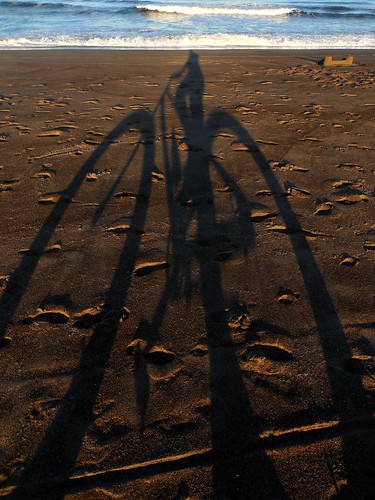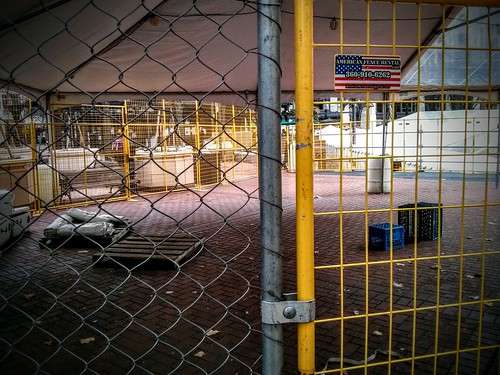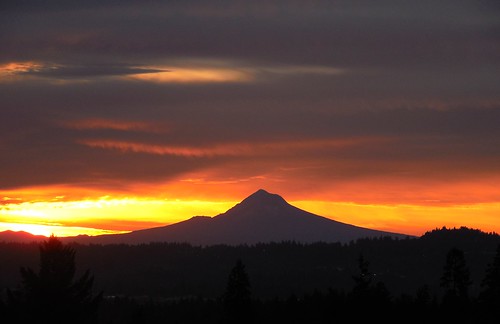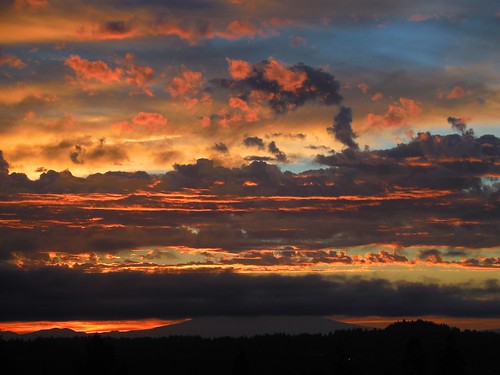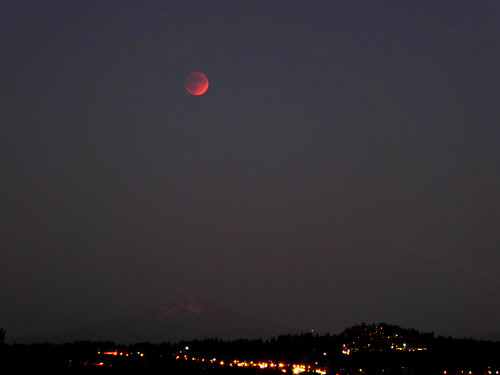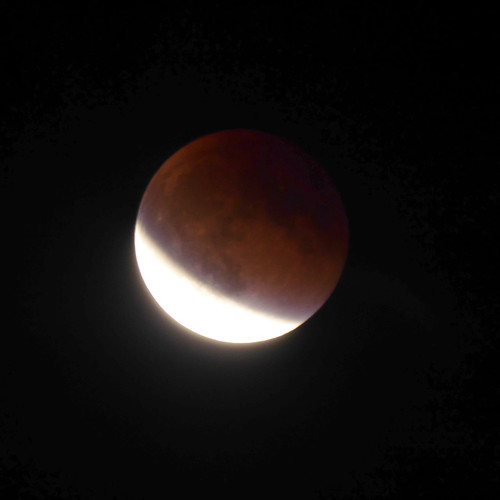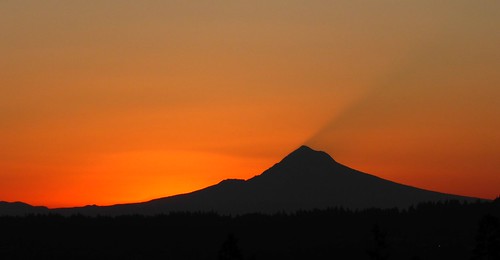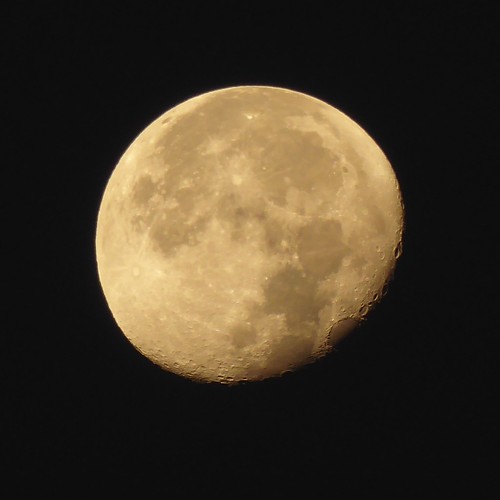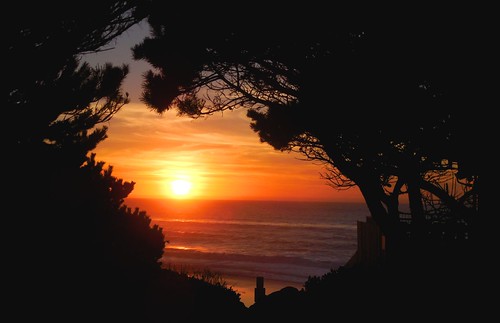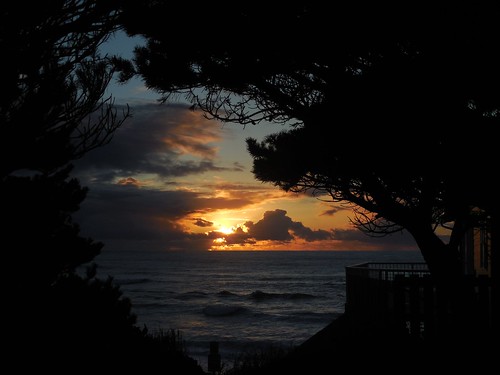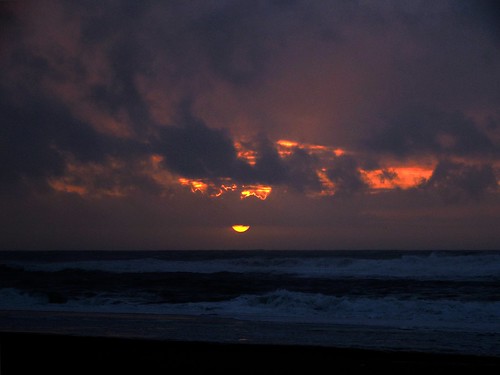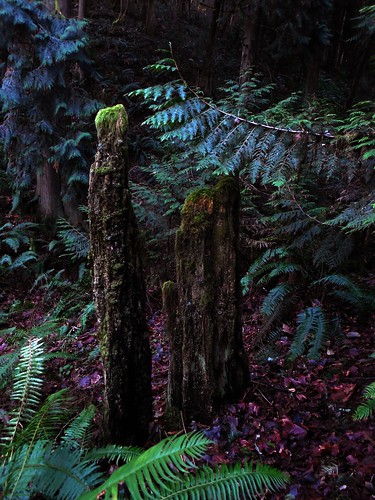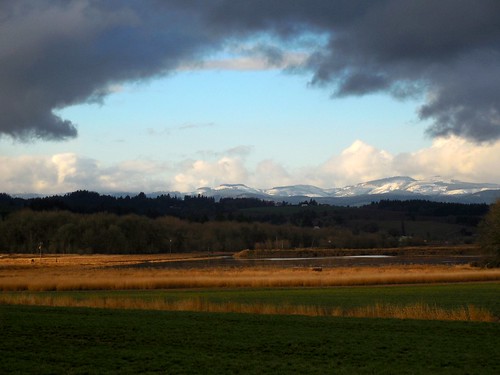The 2020 wind and fire and smoke storm
by Steve, September 19th, 2020Sunday, Sept 7
Beautiful day, and then the bone-dry east winds started, bringing the first significant smoke to the holler. We closed up the house and listened to the wind howl all night, glad we took out the killer maple hanging over our bedrooms earlier in the summer. Overnight, fires popped up all over the west slope of the Oregon Cascades and in the Siskiyous. It was still clear enough to walk the next day, but the winds were still howling.
Monday, Sept 8
On what would be my last walk for almost two weeks, I surveyed the damage from the still howling wind.
My meditation bench got hit, but was undamaged.
Made it to the top of Gabbert Butte and back, my usual 2 mile out and back. At the saddle, major blowdown and a damaged interpretive sign.
Back home, I clear my bench and sit until the creaking trees in the persistent wind convince me to go inside and stay there.
Tuesday Sept 9 – Wednesday Sept 17
Smokier and smokier every day, to the point that the AQI is off the charts, above “hazzardous.” While the east winds have stopped bringing in new smoke, a thermal inversion traps the existing smoke in the valley. We are socked in with smoke and fog. There are predictions that a weak offshore low pressure system will push in a break the inversion in a couple days, but the inversion persists. This couple days would ultimately turn into more than a week. Thermal inversions and their lifting are notoriously hard to predict. We run the furnace blower continuously. We don’t run bathroom or kitchen exhaust fans to avoid drawing in outside air. I swap our furnace filter every two days.
I’m out of fresh filters by Sunday, and nobody has stock locally. Amazon can’t get them to me until the following Saturday, Lowe’s Friday. I order them anyway, and keep my dirty filter in case the clean one gets dirtier. Maybe I can vacuum it or something. Robb offers to fed ex me some for CR.
I become intimately familiar with airnow.gov, and our nearest monitoring station consistently shows “hazardous” air quality for particulate matter.
Thursday, Sept 17
That offshore low finally looks to be breaking through. By late afternoon there are thunderstorms marching north up the coast range. Our air quality starts to gradually improve. We celebrate being upgraded to “Very Unhealthy” from “Hazardous” before bed.
We are awakened at 3:30 a.m. by a monster thunderstorm, like the kind I remember growing up in Iowa and Colorado. Bright flashes and booms all around and buckets of rain.
Friday, Sept 18
The thunder has passed, but it’s still raining in the morning. The air quality is still “Very Unhealthy,” but it starts to improve rapidly in spite of the weather service maintaining an air quality alert into Saturday. More rain moves in around 3:30, and the air quality starts to rapidly improve. Then the sun breaks, and the angel’s trumpets sound.
The new furnace filters arrive, and I swap in a new one and run it for a while. It’s still smokey outside, even if radically better than just hours earlier.
By bed time, the air quality has suddenly cleared. We open the house up for the first time. It smells wet and green outside. We sleep like babies and wake up to the sound of birds.
Saturday, Sept 19
I walk, my usual two-mile out-and-back. It’s suddenly fall.
The most dramatic end of summer I can recall. The rains have mostly stopped, and it’s supposed to clear up overnight, and be back to seasonal 70s with sun.
Beach biking the Oregon coast
by Steve, May 2nd, 2016- The first thing you’re going to need is a fat tire bike. You can spend thousands of dollars on a fancy one, rent one somewhere, or do like I did and buy a cheap department store bike and mod it. Besides fat tires, you want light weight and low gearing (my Land Shark is a 50 pound tank, and I’m kind of a tank too, but I geared it nice and low).
- Ride like the wind. We get a lot of wind at the Oregon coast, and you want to ride with it at your back as much as possible. Think about it like canoeing. Either ride into the wind (upstream) for the first half of your distance, or ride on paved streets into the wind and then on sand with the tail wind. Or, use two cars. Park one down wind at your finish point. If you’re riding both ways on sand, you really, really want to ride into the wind first. The wind can come from any direction at any time of the year, but it generally blows from the north in the summer and the south in the winter.
- Know your tides. You want to ride while the tide is going out, on the wet sand that’s been packed down by the surf. Depending on how long I’m planning to ride, I like to leave about two hours before low tide. You can ride when the tide is coming in, but…
- Be aware of sneaker waves. Know your surf conditions, and always be watching the surf. A sneaker wave can occur any time during the tidal cycle, without warning, and could easily knock you off your bike. At the very best, you’d soak your precious metal in salt water (bad; see below), but even worse, you would die and somebody else would get to ride your bike. Wouldn’t that suck? On high surf days, especially ones with wind, you’ll have more fun if you just stay home, anyway.
- Keep your bike out of the surf. It’s actually really, really fun to ride in the surf, but it’s really, really bad for your bike. Salt water eats metal and can wear away grease. It also makes sand stick to your drive train. Hose your bike off when you’re finished.
- Know your sand. Oregon’s sandy beaches range from fine sand to coarse gravel, and everything in between. Finer sand, finer ride. Coarser sand, harder slog. If you’ve got gears, you can handle the loose stuff. But you’ll have an easier cruise on the light tan sand between the surf and the tide line. The coarser sand/gravel is darker brown.

- Take water. You may not know this, but salt water is not good to drink.
- Take a bag or something to collect treasures. The biggest agates I find are on beaches not easy walking distance from places you can park a car. I always have a plastic bag strapped to my bike rack, and you can almost always find pretty rocks in my pockets.
- Take a camera to collect visual treasures. The same beach never looks the same. It changes every day.
- Be prepared to talk to people, because fat bikes draw a lot of attention. They are less of a novelty than a year ago, but there are still plenty of people who want to stop you and ask questions. If you’re feeling sociable, you will enjoy the opportunity to tell people that yes, those tires really are big and yes, they work pretty good in the sand. If you’re not sociable, get used to smiling and saying the same anyway. We try to uphold that polite Oregonian vibe for our inlander tourists.

- The sand isn’t always good. Beaches change every day, especially in the winter and spring. Our beach has some steep parts, and the flat parts tend to have a lot of gravel. Gravel on steep is the worst. With that in mind…
- Don’t worry if you have to get off and walk part of the way. Especially if you’ve got a one-speed like me. It’s all about being on the beach and getting a workout, and there is nothing wrong with a walk on the beach.
- Riding at sundown is sublime. Golden light on the waves, a little spray on your face, maybe a seal swimming along in the surf… There is nothing else like it in the world.

- Stay the hell away from seals and sea lions, especially pups (above video shot with telephoto). They may look abandoned, but mama seals often leave their pups unattended on the beach while they fetch fish. Adult seals will probably just jump in the water, but they could mess you up if they wanted to. A sea lion won’t hesitate to mess you up. (We’ve got a big harbor seal colony at the spit end of our beach.) Besides being rude, it is a federal crime to disturb marine mammals. So if they notice you and start to move toward the water, just move slowly away. I like to stay at least 100 yards away, and even that can bee too close sometimes.
- “Have a good time, all the time. That’s my philosophy, Marty.”
Making the public private, courtesy Neil Goldschmidt, Inc.
by Steve, December 6th, 2015At times like these, all I can think about is Fred Leonhardt, once the risen star of political speech-writing in Oregon, and how his career was destroyed by the still-powerful politico-corporate network of child-rapist Neil Goldschmidt. So I dedicate this to Fred and to his family, and all they’ve sacrificed to support Fred’s righteous bravery. (Here’s Nancy’s take.)
Oregon’s Port of Portland and its unique Metro regional government have long been known as warrens of sinecures for ex-Goldschmidt operatives, along with executive positions at private corps like NW Natural and Nike.
Goldschmidt is still praised by many for his civic mindedness, primarily the prioritization of rail over highways. I appreciate that, and benefit from it. (But as a daily user of regional rail transit, I can tell you Portland’s system has proven poorly designed, with many choke points, inefficient routes, and inadequate capacity, especially during any kind of weather. But I digress.) The point is, Goldschmidt’s legacy hasn’t actually been all that beneficial for the public. To the contrary. I would argue that in addition to child rape, patronage and enlarging the public trough have been his enduring legacy.
Now comes Christmas in Portland, prime season for the privatization of public space. As soon as they lit the big tree, it and the entirety of Portland’s Fucking Living Room (Pioneer Courthouse Square) is cordoned off for a privately-organized, for-admission, 21-and-over booze fest. For a week. Merry Christmas, kids! Come back next week after we’ve hauled off the drunks, taken down the tents and hosed off the bricks! To be fair, I don’t know of a Goldschmidt/booze fest connection. But the Metro/Oregon Zoo connections are long-standing and well-known.
Last week, the Oregon Zoo announced that, in an effort to thin crowds, ticket prices are going up. Yay! Fewer poor people to have to stand in line with. Not sure why the Zoo can’t figure out how to, I don’t know, sell timed tickets like every museum that ever hosted a popular exhibit. Better yet, make it free, and have a lottery for available time slots. Our taxes are paying for it, so why should we pay twice? Oh, that’s right, so Metro can continue to host six-figure jobs for the Goldschmidt network.
And who’s quoted in the O, pimpin’ the price hike? None other than Krista Swan, who’s never been shy about her public adoration of “the man” Neil Goldschmidt.
“It should be a magical, fun experience,” said Swan. For those who can spare 50 or 100 bucks to take their families to see lighted cages. (I know, I know, they don’t actually light the cages. But the whole place is a damn cage.)
It’s naked elitism. They don’t give a fuck. I kind of admire the chutzpah it takes to say “screw you” to the people paying your salary and totally get a way with it. But I literally feel sickened by this.
My long-term, ongoing revulsion of zoos was recently enhanced by a $125 million zoo bond that was supposed to provide a large, off-exhibit elephant sanctuary for surviving victims of the zoo’s shameful captive breeding and exhibition program. As a pioneering captive elephant breeder (and one of few remaining), the Oregon Zoo has long used elephants as the face of its marketing campaigns. At some point after the bond was passed, the zoo decided they were going to spend that public money on exhibit space, and maybe think about a sanctuary some time in the future. Let’s not kid ourselves; the improved exhibit space is designed as an improvement for ticket-buying human spectators, not elephants.
The zoo has launched a massive outdoor media campaign promoting the new exhibit. The over-sized billboard hung from the side of the O Dock grain elevator in the Rose Quarter reminds me of Portland past, where there were industrial jobs that paid enough for a family to survive and buy a house. Now their tax dollars are paying to advertise the offensive, unethical exhibition of elephants they probably can’t afford a ticket to see.
I really hate the zoo. It’s a publicly-funded, commercial entertainment enterprise that is cruel to animals and increasingly off-limits to working people. At this point, I would be in favor of full privatization (with fair market price for the land and facilities). And we should legislate an end to captive breeding of elephants. End of story.
This is a salient piece of the Goldschmidt story: how he created an elite and powerful network that survived his rape of a child, and continues to make public policy decisions largely for their own benefit, paid for by working people.
Update, 2:50 pm
Poor Krista thinks we’re picking on her.

Also, we don’t get it! It’s actually cheaper for the masses if they pack in on poor people nights! And she can’t be elitist, she scrubs baseboards with a toothbrush! (?)
And we must be living in the past to continue pointing out Goldschmidt’s nefarious influence. Also, we might need therapy.
Here’s a public official, complaining about hearing from her constituents. I’m afraid it’s Krista who doesn’t understand how public debates about public policy regarding public spaces are supposed to work.
Nutria-henge-quinox, autumn 2015
by Steve, September 30th, 2015On the seventh day after the vernal and autumnal equinoxes, the sun rises above the the highest point in the East, a snow-capped volcano named Wy’east and Hood, when viewed from the ridge named Cooper in the Tualatin Valley on this planet called Earth we are born of.
At first, when we began our residence on this ridge, we were not aware of the icy, brooding peak beyond the green Tualatin Mountains, until the skies cleared that Spring. It may have been the following fall, or the next spring that I first noticed the sun crossing Hood near the equinox. It was another equinox or two later that I discovered the deep and steady rhythm of it.
We live on an astral clock, Mt. Hood the style on a planetary sundial for this particular location. Upon first discovering the division of sunrises, spring and summer north, fall and winter south of Mt. Hood, I dubbed it Nutriahenge, for the furry denizens of the wetlands and streams of the valley (and the triliths of Wiltshire).
The equinoxes mark the points in the earth’s orbit where the its tilted axis is perpendicular to the sun’s rays, and the days and nights are equal. As we swing around the ellipse of our orbit now, the northern half of the planet is tipping away from the sun, sliding us into longer nights and shorter days.
This year, I’ve declared a new sacred festival, in my personal church of the universe, in honor of nutriahenge, a week-long observance of the sun crossing Mt. Hood. Beginning sunrise on the equinox, Nutria-henge-quinox week culminates eight days later with the sun rising over the summit of our nearest volcano.
This first official Nutria-henge-quinox week was marked with a special celestial alignment, the rising of the fully eclipsed super moon above Mt. Hood on the Sunday midway between the two Wednesdays of equinox and nutria-henge-quinox.
The week started with some broken skies and the sun beginning its approach to the northern slopes of Hood.
The universe painted with a full pallette encouraging us to join the celebration of light.
(The universe doesn’t care about you and me, that’s just a literary device. It’s called personification. We humans do a lot of it and shouldn’t take things so literally. This is a basic tenet of my nature church.)
Then, on Sunday, the moon rose red out of the haze, and soared above Hood.
Our planet cast its shadow across its satellite, but the fleet moon was soon revealed in its former brilliance.
In the days before the crossing, the rising sun causes Mt. Hood to cast a shadow in the haze, up and to the south, betraying the sun’s position beneath the horizon.
By the morning of nutria-henge-quinox, the moon had regained its brilliance, but was losing its shape to its drifting phase, revealing mountains and crater walls in the shaddows.
And then the sun rose, the closing act of the festival, a breathtaking dance of earth, moon and star.

We’re just specks of self-aware stardust, hydrogen and carbon and oxygen, wandering the surface of this wet rock looking for meaning. I say look up. See yourself as an infinitesimal piece of this infinitely beautiful universe. That’s all you need to know. That’s all there is. Peace out.
And the sun went down
by Steve, July 17th, 2015
Lots of jellies have been beaching. I don’t know why.
(Are they really jellies or just some gelatinous goo?)
The sea is a mysterious place, at once inviting
And foreboding.
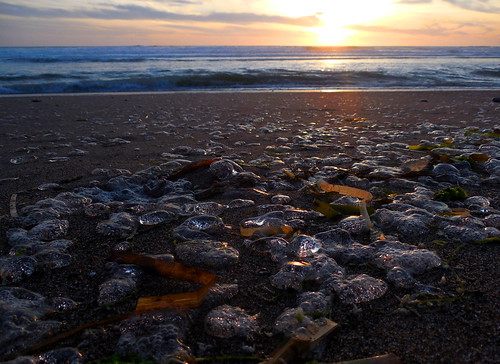
When the sun hits the water there is a tremendous rumbling hiss
And a spew of steam (no not really; the sun doesn’t actually go into the water,
That would make a really big mess; it just looks like that).
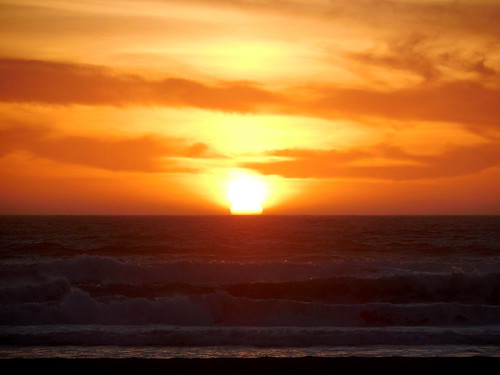
The caps of the waves, lit from behind, bring to mind a wave form,
Electrical energy mapped on a back-lit screen, green flashes of consciousnes
Flitting up down and past me like the hummingbirds in the yard
This afternoon when I watered.
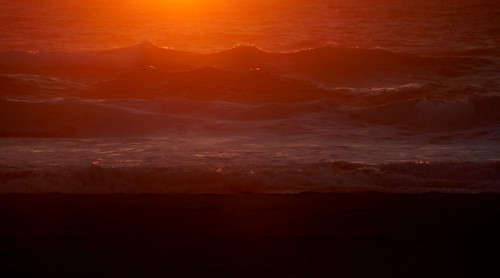
There are angels in the clouds, flying north; the mother reaches out to her child
Sheltering and guiding her with her wings
Like the migrating gray whales in the spring, teaching their calves to feed
In our fertile water. It’s a 3-D painting that changes while you watch it.
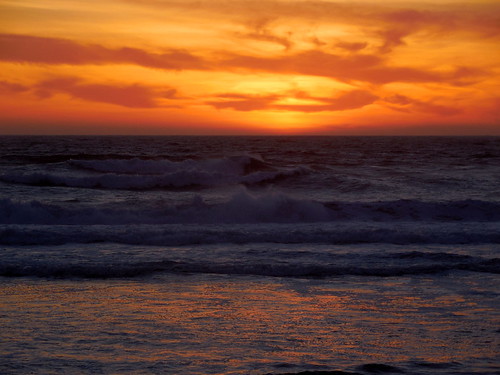
The sunset doesn’t end, it just keeps going, a traveling light show
Rolling around the globe.
The big waves are just tiny ripples, out beyond this log I’ve used before.

From up above, I see a seal in the surf in the twighlight
And rays fade into being radiating from the source.
The seal feels the wind when she comes up for air
(Does she feel the sun?),
And is pulled on unseen currents below.
There is a bat on the way home, winging crookedly around the chimneys
Capped with conquistador helmets which squeak as the wind swings north.


